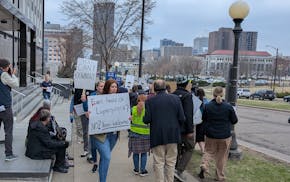Anti-pipeline groups asked a federal judge in Minneapolis on Thursday to halt the increased flow of crude oil from Canada into Minnesota resulting from 2014 upgrades at a short section of pipeline across the international border.
But lawyers for pipeline owner Enbridge Energy and the U.S. State Department told Senior U.S. District Judge Michael Davis that the modifications to boost the oil flow are allowed under an existing federal cross-border permit.
Davis took the matter under advisement but expressed wariness during a 2½-hour oral argument about the legal grounds to issue an injunction. "Are you asking me to go where no judge has gone before?" Davis said to the pipeline opponents' attorney.
Seven environmental groups and an American Indian band sued the State Department for accepting a plan by Calgary-based Enbridge to increase the flow of heavy crude oil from Alberta into the United States and across Minnesota while a federal environmental study is still underway.
The lawsuit, filed in November, alleged that the State Department violated the National Environmental Policy Act and other laws. The groups seek an injunction to halt the flow of oil.
At a post-hearing news conference outside the federal courthouse, activist Winona LaDuke, founder of Honor the Earth, said she "found it alarming that Enbridge and the State Department acted as if the federal court had no jurisdiction." She said tribal areas have been crossed by pipelines for decades, with little regard for the effects on native people.
"What we are seeing is a pretty rapid destruction of the entire ecosystem in northern Minnesota," said LaDuke, a White Earth member who raises wild rice and sells it and other products online. "These pipelines are a part of that."
Kenneth Rumelt, an attorney who argued in court for pipeline opponents, called the increased flow on the Enbridge pipeline system in Minnesota a "quiet Keystone."
That's a reference to the controversial Keystone XL pipeline proposed by TransCanada from Canada through western states. It awaits a decision from President Obama on whether to issue a Presidential Permit allowing increased Canadian oil across the border.
Legal issues at play
Inside the courthouse, the legal arguments focused on another Presidential Permit, signed by President Lyndon Johnson in 1968, for a then-new pipeline to carry Canadian crude oil into the United States. The line crosses northern Minnesota on its way to Superior, Wis.
In 2014, Enbridge replaced the steel pipe on a 16-mile section of the line at the U.S. border and added valves so crude oil could be shifted between it and a parallel pipeline awaiting approval for increased flows across the border.
This bypass allowed significantly expanded shipments by Enbridge by shifting the flow between the two lines — but only at the border. More oil could be carried on Enbridge's recently upgraded Alberta Clipper pipeline even though a federal environmental review of its increased flow was only getting started and still isn't finished.
The Sierra Club, Honor the Earth, the White Earth Nation and other groups want the judge to halt the increased flow, arguing that the State Department was wrong not to object to the border pipeline modifications last year.
But Luther Hajek, a U.S. Justice Department environmental attorney, defended the State Department's acquiescence to the changes. He said the pipe replacement was allowed under Enbridge's existing border permit and the new valves are outside the area subject to State Department jurisdiction.
He said the State Department gave no approval, and took no "major federal action" — the trigger point for environmental review.
Enbridge weighs in
Enbridge is not a defendant in the case, but had intervened on the government's side. The company's attorney, David Coburn, argued that the U.S. Transportation Department, not the State Department, has the main responsibility for pipeline safety and that the Minnesota Public Utilities Commission must approve new crude oil pipelines in the state.
Enbridge currently has two pipeline projects being reviewed by the PUC, including the replacement of the 1960s-era Line 3 whose border alterations are at the heart of the lawsuit.
The other groups in the lawsuit are the Indigenous Environmental Network, Minnesota Conservation Federation, MN350, the Center for Biological Diversity and the National Wildlife Federation.
They also are concerned that Enbridge's project to replace Line 3 apparently won't trigger a federal environmental review as was done for the Keystone XL and the Alberta Clipper projects.
Enbridge contends the Line 3 replacement project doesn't need a new cross-border permit because the original one "does not limit the capacity on the line, therefore, no amended or new Presidential Permit will be needed," the company said in an e-mail.
That 1960s-era pipeline has produced some of Minnesota's worst oil spills, including those depicted on photos carried by anti-pipeline protesters outside the courthouse.
Opponents also raised concern that Enbridge's replacement plan for Line 3 calls for the old line to remain in the ground, potentially allowing it to be put back into service.
Coburn said U.S. industry practice is to leave old pipelines in the ground — unused — because digging them up can cause environmental problems. The argument that Enbridge could revive the line is "a bogus claim," he told the judge.
David Shaffer • 612-673-7090 Twitter: @ShafferStrib
Minnesota's med spa industry rises in popularity — and with little regulation

Ramstad: Readers say Walmart won't be paying the ultimate price of Trump's tariffs

How Minnesota businesses can spot and prevent invoice fraud
No place for cryptocurrency in retirement portfolios

